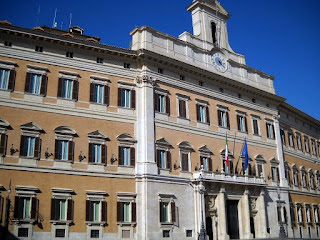Movement that gave media magnate Silvio Berlusconi political power
 |
| The Forza Italia logo, displaying the colours of the Italian flag, soon became a familiar sight |
Work had been going on behind the scenes to lay the foundations of the party for several months, going back to Berlusconi and a group of friends and business colleagues meeting in a notary’s office in Milan in June 1993 to give legal status to what was called the Forza Italia Association for Good Government.
By November, a network of Forza Italia Clubs was established, quickly attracting many thousands of members. Details of this network appeared in the media, although Berlusconi denied that they were branches of a political party - despite news in December that an address on Via dell'Umiltà in Rome had been registered as Forza Italia headquarters. Its office was in the same building that once housed the headquarters of the Italian People's Party, a forerunner of the Christian Democracy party.
On January 18, 1994, however, it was confirmed that Forza Italia would be fielding candidates in the elections due to be held in March of that year.
Il Movimento politico Forza Italia, to give the party its full title, emerged from a period of profound political upheaval in Italy, when the traditional powers of the nation’s political history were swept away in a far-reaching corruption scandal uncovered by the Milan magistrate Antonio Di Pietro and his team of investigators.
 |
| The charismatic Berlusconi was a natural vote winner for the party |
Amid this turmoil, filling the void in particular left by the once all-powerful Christian Democrats, Berlusconi, the former property investor who made his fortune after launching Italy’s first private TV network, saw his opportunity to launch a bid for political power.
Drawing on a line from a popular football chant in his choice of Forza Italia as its name, Berlusconi and his allies designed a party that would stand for market-oriented economic policies and a strong national identity combined with traditional conservative values. The party advocated lower taxes, minimal government intervention in the economy and law changes aimed at boosting economic growth.
They wanted to focus their appeal towards moderate voters, former Christian Democrat voters largely, who were - in Berlusconi’s own description - "disoriented, political orphans and who risked being unrepresented".
In fact, the words ‘forza Italia’ - literally ‘Italy force’ but interpreted by English-language commentators as meaning something akin to ‘Go Italy’ - had previously appeared in Christian Democrat slogans during the 1987 election campaign.
An individual with natural charisma, Berlusconi had both the image and the resources to turn the new party into an overnight success. He managed the project himself as both a successful businessman and, by challenging the broadcasting monopoly of the state-owned Rai network, an establishment outsider. Meanwhile, his television channels - Canale 5, Rete 4 and Italia 1 - provided a ready-made platform to connect with the public. His own personality won many of Forza Italia's votes.
.jpg) |
| Berlusconi waves to a cheering crowd during his third successful campaign for office |
Forza Italia’s immediate success, winning 366 seats in the Chamber of Deputies as the largest party at the 1994 elections, came after Berlusconi had formed a campaigning alliance in the north with Umberto Bossi’s Lega Nord, and in the south with Gianfranco Fini’s post-fascist Alleanza Nazionale, two parties who for the most part despised one another. Lega Nord left the coalition in December and Berlusconi’s first stint as prime minister ended after just 251 days but uniting Bossi and Fini for even a few months could be seen as remarkable.
The centre-left held away for the next five years but Forza Italia regrouped and won power again in 2001 after Berlusconi had brought together the disparate ambitions of north and south again in his Casa delle Libertà - House of Freedoms - alliance.
This time, Forza Italia and their allies having won almost a third of the vote, Berlusconi was installed as prime minister for a second time, staying in post for four years and 340 days, his executive proving to be the longest lived in the history of the Republic.
Despite being investigated over numerous scandals during his next period in opposition, Berlusconi won a third term as prime minister in 2008, although this time under the banner of Il Popolo della Libertà - People of Freedom - after joining forces with Fini’s Alleanza Nationale. This time, he stayed in office for three years and 192 days.
The merger between the two parties meant that Forza Italia did not officially exist between 2008 and 2013 but with the disbanding of the People of Freedom it was relaunched. Although barred from office himself after being convicted of tax fraud, Berlusconi remained the party’s figurehead until his death in 2023, having been elected to the Senate after his ban expired.
The reformed Forza Italia has yet to achieve the same level of popularity as the original version but remains a significant player in Italian politics and was part of the centre-right coalition led by Fratelli d’Italia (Brothers of Italy), whose victory at the 2022 elections put current prime minister Giorgia Meloni in power.
 |
| The Trevi Fountain in Rome, with its backdrop of the Palazzo Poli, is one of Rome's best-known sights |
The Via dell'Umiltà in Rome is part of the Trevi district in the heart of the city. A beautiful, elegant and historic neighbourhood, it is best known for the Trevi Fountain, which was officially opened in 1762 and has become one of the city’s best-known landmarks. The district is also home to the Palazzo Barberini, the 17th century palace to which three of Rome’s greatest architects - Carlo Maderno, Francesco Borromini and Gian Lorenzo Bernin - all contributed and which now houses part of the collection of Italy’s National Gallery of Ancient Art. Other notable sights in the district are the Fontana del Tritone and Fontana Barberini, the Palazzo Colonna and the Palazzo Quirinale, official residence of the Italian president.
%20(1).jpg) |
| The Palazzo Chigi, off the Via del Corso, is the official residence of the Italian prime minister |
Silvio Berlusconi’s official residence during his terms in office as prime minister was the 16th-century Palazzo Chigi, which overlooks the Piazza Colonna and the Via del Corso in Rome. The palace was in the ownership of the Chigi family, part of Roman nobility, from 1659 until the 19th century. It became the residence of the Austro-Hungarian Ambassador to Italy in 1878 before being bought by the Italian state in 1916, when it became the home of the Minister for Colonial Affairs. Later it was the official residence of the Italian Minister of Foreign Affairs and in 1961 became the official meeting place of the Council of Ministers, whose president is the head of the Italian government - the prime minister - and who was allowed to use the palace as his official home in Rome.
Also on this day:
1543: The birth of musician Alfonso Ferrabosco the elder
1880: The birth of cardinal Alfredo Ildefonso Schuster
1946: The birth of operatic soprano Katia Ricciarelli
1950: The birth of basketball player Dino Meneghin
.jpg)



_(cropped).jpg)




























